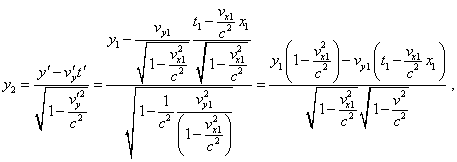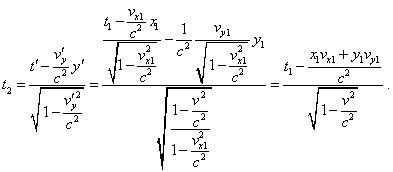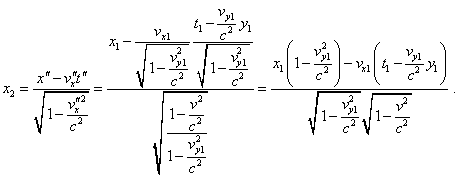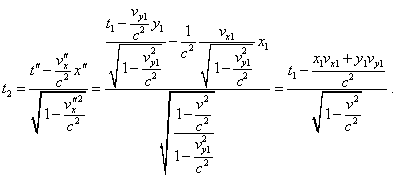SELF |
2 |
S.B. Karavashkin and O.N. Karavashkina |
|
|
|
SELF |
2 |
S.B. Karavashkin and O.N. Karavashkina |
|
|
|
2.2. Solution through the sequential passing through the intermediate frame In this approach to the problem we will use the intermediate frame moving with the speed of one of projections of the speed S2 , transforming the coordinates of the initial frame S1 into S2 through this auxiliary frame. And since we can with equal right relate the motion of intermediate frame with any of two projections of speed, the problem has two basic variants of solution. Consider them both. 1 VARIANT of solution In this variant we will seek the expressions that describe the transforms through the sequential passing from S1 to some intermediate frame S' moving with respect to S1 with the positive values of x1 with the speed vx1 , as it is shown in Fig. 2, and as the second step of this variant we will pass from S' to S2 and yield the sought result.
|
Fig. 2. The scheme of motion of the intermediate IRF S' along the axis x1 of the resting IRF S1
|
We would like to especially mark: as it is seen from the construction, the axes x' and y' are strongly parallel to the axes x1 and y1 and we bear in mind no turns of axes of the frame S' relative to S1 or S2 in the course of solution, which will be well seen in the expressions that we will apply to find the equations of coordinate transform both at the first and second step of solving. Below we will prove this point. I STEP At this step we have to yield the formulas of transform in passing from S1 to S' . This is easy to do, as the sought expressions fully coincide with the expression that Einstein used (see, e.g., [1, p. 17–18]): |
 |
(1) |
In these expressions and further, we will not write the projection onto the axis z1 , as after the statement, we consider the plane problem. II STEP To find the equations of transforms from S' to S2 , we have to find the speed of its motion with respect to S' . For it, put to the coordinate origin of S2 some body A2 that moves with it, as we showed it in Fig. 3. |
Fig. 3. Location of the body A2 relative to the frames S2 and S'
|
Then, according to the statement of problem, the projections of speed of this body from the point of S1 will be determined by the same values as the given values of projections determining the motion of S2 with reference to S1 , i.e. vx1 and vy1 relatively. To find the speed and direction of the body A2 in S' , use the theorem of relativistic summation of speeds. In the 2-D case, in passing from the resting frame to that moving with the speed v in the positive direction of the axis x of resting frame, these expressions will be (see e.g. [2, p. 31]) |
 |
(2) |
where u'x and u'y are the body’s projections in the moving frame, and ux and uy are, relatively, the projections of the speed in the resting frame. In our problem |
| (3) |
Given (3), (2) will take the following form: |
 |
(4) |
In (4) we see that A2 moves with reference to S' strongly in the positive direction of the axis y' . So the equation of transform from S' to S2 will be |
 |
(5) |
Now to find the final solution, it remains to join (1) and (5) and to account (4). So we yield for the x-projection |
 |
(6) |
for the y-projection |
 |
(7) |
where v2 = v2x1 + v2y1 , and for the t-projection |
 |
(8) |
The expressions (6)–(8) describe the sought transforms from S1 to S2 with account of relativistic transform of speeds. 2 VARIANT of solution Now let us solve this problem by the second variant, passing otherwise from S1 to S2 . To do so, introduce another auxiliary frame S" that will move in the positive direction of the axis y1 with the speed vy1 , as we see in Fig. 4. In this approach we first will pass from S1 to S" and then, using the above technique, pass from S" to S2 , joining the equations of transform in the end of solving.
|
Fig. 4. The scheme of motion of the intermediate IRF S" along the axis y1 of the resting IRF S1
|
We see from the construction in Fig. 4, in this variant the intermediate frame is shifted in the positive direction of the axis y1 , also remaining axes x" and x1 parallel, and it will have an effect in the applied expressions in the course of solving after this variant. We would also emphasise that in classical physics these two approaches give same solution, as the law of parallelogram is true there. In the relativistic formalism this law does not work, and Einstein stated that the law of parallelogram “is based on the arbitrary and unacceptable hypotheses” [3, p. 151]. Now we will see what we yield in case if the untrue law of parallelogram is ‘acceptable’. I STEP At this step we have to pass from S1 to S" . As S" moves in the positive direction of y1 with the speed vy1 , the sought formulas of transform will be similar to (5): |
 |
(9) |
We see from (9) that in the motion along y1 the frame did not change its orientation with reference to S1 , but now, comparing with the first step of the first variant (1), the axis y" has been transformed and x" remained unchanged; this is natural, as S" moves along y1 . And a simple fact that in case if (9) were written as the result of turn, the projection x" would be negative and the motion would occur with x" , not y", and the time relationship would be other, speaks that any turn is absent. And (9) clearly is fully similar to a trivial system of transform, with the only difference that the motion of moving frame occurs not with x1 , as in (1), but with y1 . II STEP To find correctly the transform of speed vx1 in passing to S" , introduce, just as in the first variant, the same body A2 resting in S2 whose transform of speed we can easily find and in this way find the speed of S2 in S" , see Fig. 5.
|
Fig. 5. Arrangement of the body A2 relative to the frames S2 and S"
|
As the graphs in Fig. 3 and Fig. 5 differ only in direction of motion of the intermediate frame, the expression (2) for the relativistic addition of speeds used above will remain true, we only have to change in it the correspondence of parameters. In case of motion of S" this substitution will be |
| (10) |
With it, we will find the projections of the speed of A2 relative to S" as |
 |
(11) |
Thus, the body A2 moves relative to S" strongly along x" . With account of (11), the transforms from S" to S2 will take the form similar to (1): |
 |
(12) |
To find the sought equations of transform from S1 to S2 , it remains to join (9) and (12) with account of (11). So we yield for the x-projection |
 |
(13) |
Comparing (13) with the solution for same projection in the first variant (6), we see that solutions are not same. This solution is close to that for the y-projection with account of interchange of symbols x and y. But this likeness is not associative with the conditions of the solved problem, as we did no turns of axes and no re-name of axes. And should this likeness were caused by the turn by 90?, then, to achieve the likeness with (6), we would have to account in (13) the change of vx1 by - vx1 because of change of direction of the axis x in the turn. And since the correspondence is established without this substitution of the projection of speed, the turn is absent and likeness is only outward. For the y-projection yield |
 |
(14) |
The transforms for this projection are also inconsistent with (7) of the first solution but only are like the solutions for the x-projection – again, with the interchange of symbols x and y. And again, this is incorrect from the point of determinacy of processes in physics. Finally, for the t- projection yield |
 |
(15) |
Comparing (15) with (8), we see a full correspondence of solution for the time component. |